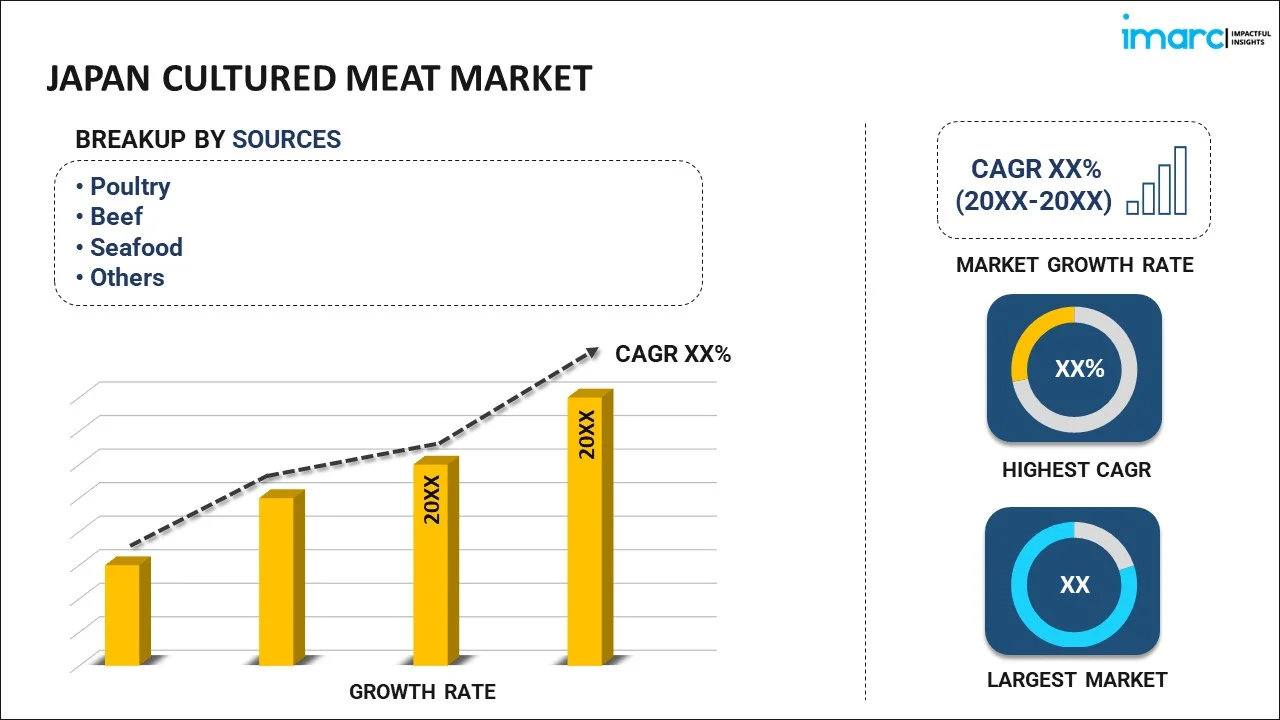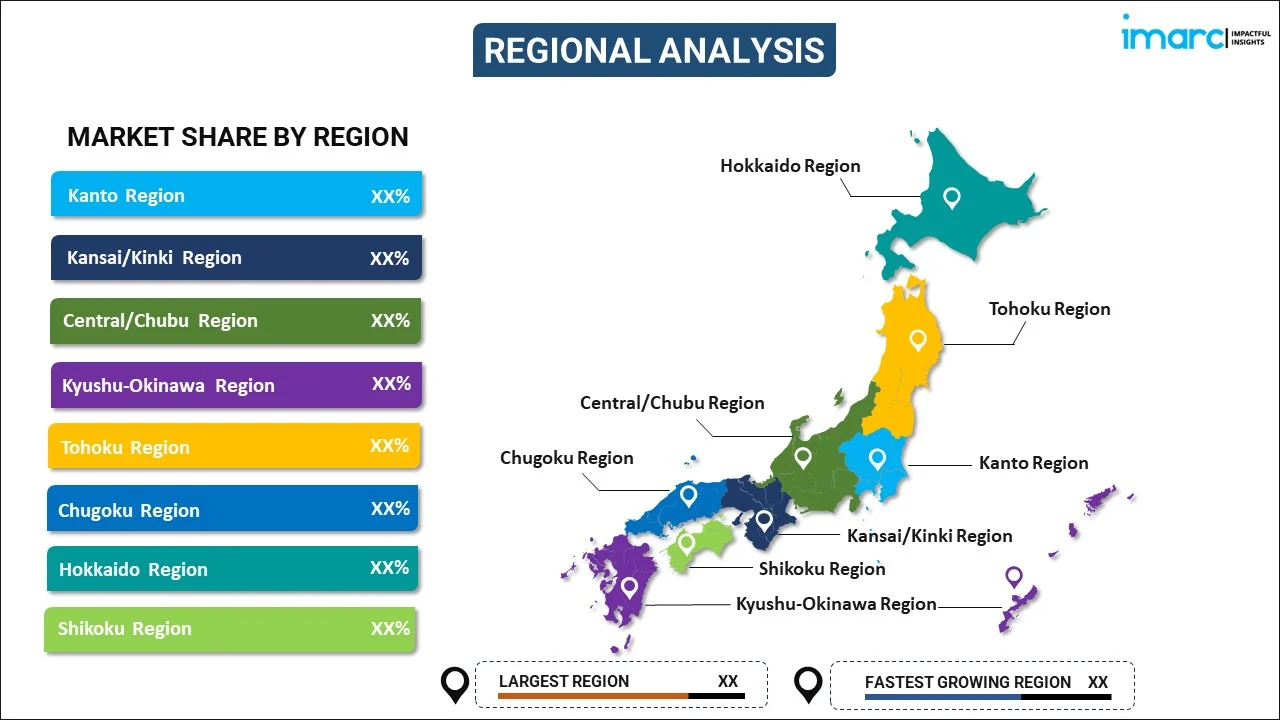
Japan Cultured Meat Market Report by Source (Poultry, Beef, Seafood, Pork, Duck), Application (Nuggets, Burgers, Meatballs, Sausages, Hot Dogs), End User (Household, Food Services), and Region 2025-2033
Market Overview:
Japan cultured meat market size reached USD 13.7 Million in 2024. Looking forward, IMARC Group expects the market to reach USD 68.3 Million by 2033, exhibiting a growth rate (CAGR) of 18.53% during 2025-2033. The widespread adoption of nutritional diets, along with the rising awareness among individuals towards the benefits of cultured meat, such as eliminating the need to raise animals, low environmental impact, and decreasing public health risks, is primarily driving the market growth.
|
Report Attribute
|
Key Statistics
|
|---|---|
|
Base Year
|
2024 |
|
Forecast Years
|
2025-2033 |
|
Historical Years
|
2019-2024
|
| Market Size in 2024 | USD 13.7 Million |
| Market Forecast in 2033 | USD 68.3 Million |
| Market Growth Rate (2025-2033) | 18.53% |
Cultured meat, or cultivated meat, is grown in labs using a small number of animal cells, entirely avoiding the need to slaughter animals. This innovative approach eliminates the necessity of traditional animal farming and safeguards against potential contamination, such as E. coli, commonly found in traditional meat processing facilities. Furthermore, the production of cultured meat is more environmentally friendly, as it requires less land, water, and generates fewer pollutants compared to the conventional meat industry, which contributes to the release of greenhouse gases like methane (CH4), carbon dioxide (CO2), and nitrous oxide (N2O).
Japan Cultured Meat Market Trends:
The cultured meat market in Japan is experiencing significant growth and garnering increasing attention due to its potential to revolutionize the way meat is produced and consumed in the country. Japan, a nation with a deep culinary tradition and a strong emphasis on food safety, is increasingly recognizing the benefits of cultured meat, which is acting as significant growth-inducing factor. One of the primary drivers is the growing awareness of its environmental advantages. With limited arable land and concerns about resource scarcity, Japan is looking to reduce its environmental footprint. Cultured meat production requires significantly less land and water compared to conventional livestock farming and has a lower impact on greenhouse gas emissions, aligning with Japan's sustainability goals. Furthermore, the high level of food safety and quality control associated with cultured meat production is resonating with Japanese consumers, who are known for their discerning tastes, thereby positively influencing the regional market. Apart from this, the elimination of the risk of contamination and diseases commonly associated with traditional meat processing is a compelling factor. As research and development in the cultured meat sector continue to advance, and with increased investment and government support, the regional market is expected to propel over the forecasted period.
Japan Cultured Meat Market Segmentation:
IMARC Group provides an analysis of the key trends in each segment of the market, along with forecasts at the country level for 2025-2033. Our report has categorized the market based on source, application, and end user.
Source Insights:

- Poultry
- Beef
- Seafood
- Pork
- Duck
The report has provided a detailed breakup and analysis of the market based on the source. This includes poultry, beef, seafood, pork, and duck.
Application Insights:
- Nuggets
- Burgers
- Meatballs
- Sausages
- Hot Dogs
A detailed breakup and analysis of the market based on the application have also been provided in the report. This includes nuggets, burgers, meatballs, sausages, and hot dogs.
End User Insights:
- Household
- Food Services
The report has provided a detailed breakup and analysis of the market based on the end user. This includes household and food services.
Regional Insights:

- Kanto Region
- Kansai/Kinki Region
- Central/ Chubu Region
- Kyushu-Okinawa Region
- Tohoku Region
- Chugoku Region
- Hokkaido Region
- Shikoku Region
The report has also provided a comprehensive analysis of all the major regional markets, which include Kanto Region, Kansai/Kinki Region, Central/ Chubu Region, Kyushu-Okinawa Region, Tohoku Region, Chugoku Region, Hokkaido Region, and Shikoku Region.
Competitive Landscape:
The market research report has also provided a comprehensive analysis of the competitive landscape. Competitive analysis such as market structure, key player positioning, top winning strategies, competitive dashboard, and company evaluation quadrant has been covered in the report. Also, detailed profiles of all major companies have been provided.
Japan Cultured Meat Market Report Coverage:
| Report Features | Details |
|---|---|
| Base Year of the Analysis | 2024 |
| Historical Period | 2019-2024 |
| Forecast Period | 2025-2033 |
| Units | Million USD |
| Scope of the Report | Exploration of Historical Trends and Market Outlook, Industry Catalysts and Challenges, Segment-Wise Historical and Future Market Assessment:
|
| Sources Covered | Poultry, Beef, Seafood, Pork, Duck |
| Applications Covered | Nuggets, Burgers, Meatballs, Sausages, Hot Dogs |
| End Users Covered | Household, Food Services |
| Regions Covered | Kanto Region, Kansai/Kinki Region, Central/ Chubu Region, Kyushu-Okinawa Region, Tohoku Region, Chugoku Region, Hokkaido Region, Shikoku Region |
| Customization Scope | 10% Free Customization |
| Post-Sale Analyst Support | 10-12 Weeks |
| Delivery Format | PDF and Excel through Email (We can also provide the editable version of the report in PPT/Word format on special request) |
Key Questions Answered in This Report:
- How has the Japan cultured meat market performed so far and how will it perform in the coming years?
- What has been the impact of COVID-19 on the Japan cultured meat market?
- What is the breakup of the Japan cultured meat market on the basis of source?
- What is the breakup of the Japan cultured meat market on the basis of application?
- What is the breakup of the Japan cultured meat market on the basis of end user?
- What are the various stages in the value chain of the Japan cultured meat market?
- What are the key driving factors and challenges in the Japan cultured meat?
- What is the structure of the Japan cultured meat market and who are the key players?
- What is the degree of competition in the Japan cultured meat market?
Key Benefits for Stakeholders:
- IMARC’s industry report offers a comprehensive quantitative analysis of various market segments, historical and current market trends, market forecasts, and dynamics of the Japan cultured meat market from 2019-2033.
- The research report provides the latest information on the market drivers, challenges, and opportunities in the Japan cultured meat market.
- Porter's five forces analysis assist stakeholders in assessing the impact of new entrants, competitive rivalry, supplier power, buyer power, and the threat of substitution. It helps stakeholders to analyze the level of competition within the Japan cultured meat industry and its attractiveness.
- Competitive landscape allows stakeholders to understand their competitive environment and provides an insight into the current positions of key players in the market.
Need more help?
- Speak to our experienced analysts for insights on the current market scenarios.
- Include additional segments and countries to customize the report as per your requirement.
- Gain an unparalleled competitive advantage in your domain by understanding how to utilize the report and positively impacting your operations and revenue.
- For further assistance, please connect with our analysts.
 Inquire Before Buying
Inquire Before Buying
 Speak to an Analyst
Speak to an Analyst
 Request Brochure
Request Brochure
 Request Customization
Request Customization




.webp)




.webp)












